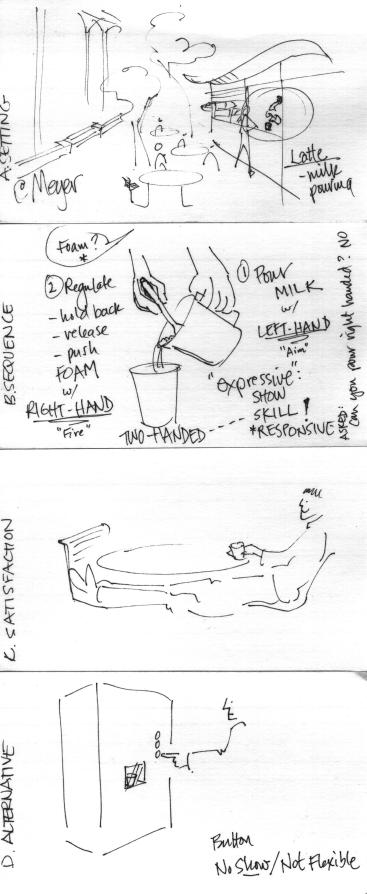250A 2013 HW 3
From CCRMA Wiki
Revision as of 07:27, 9 October 2013 by Sleitman (Talk | contribs) (Created page with '<font size=5>DUE MONDAY 10/7 </font> <font size=5>PART 1: Buttons vs. Handles </font> by Bill Verplank * One way to distinguish the ways we DO things is with HANDLES or BUTT…')
DUE MONDAY 10/7
PART 1: Buttons vs. Handles
by Bill Verplank
- One way to distinguish the ways we DO things is with HANDLES or BUTTONS.
- Buttons are discrete, handles continuous. With a button you initiate and let go; with a handle you grab on and contol. Button clicks are more likely symbolic - we string them together. Handles are more analogic - we gesture and indicate.
- Bring to class two sketches (8-1/2 x 11); one of a ``handle one of a ``button".
- Sketch enough of the context so it is clear where and who might use it.
- List the features that make this a good or bad example - what you like or don't.
- Tips:
- You will present these to everyone in the class. Use a Sharpie.
- The drawing should be self-explanatory. Use as few words as possible.
- Make it clear how the user interacts with it. Where are the user's hands?
Part 2 - Expressive Scenarios
PART 3: Reading
1 - Interaction Design Sketchbook by Bill Verplank
https://ccrma.stanford.edu/courses/250a/lectures/IDSketchbok.pdf
2 - Readings from Universal Principles of Design by Lidwell, Holden and Butler
Each short chapter will be assigned to 2 people. Those 2 people should be able to give a brief summary and draw 1 example of an object/invention that they have seen that uses this principle. Each drawing should by o 8.5 x 11" paper.
